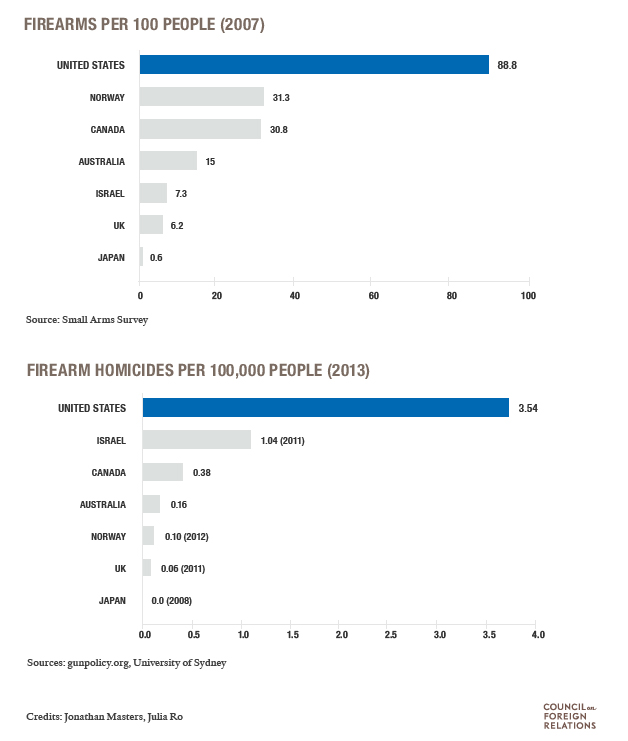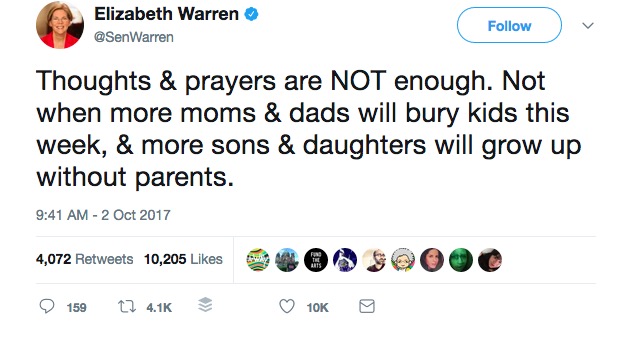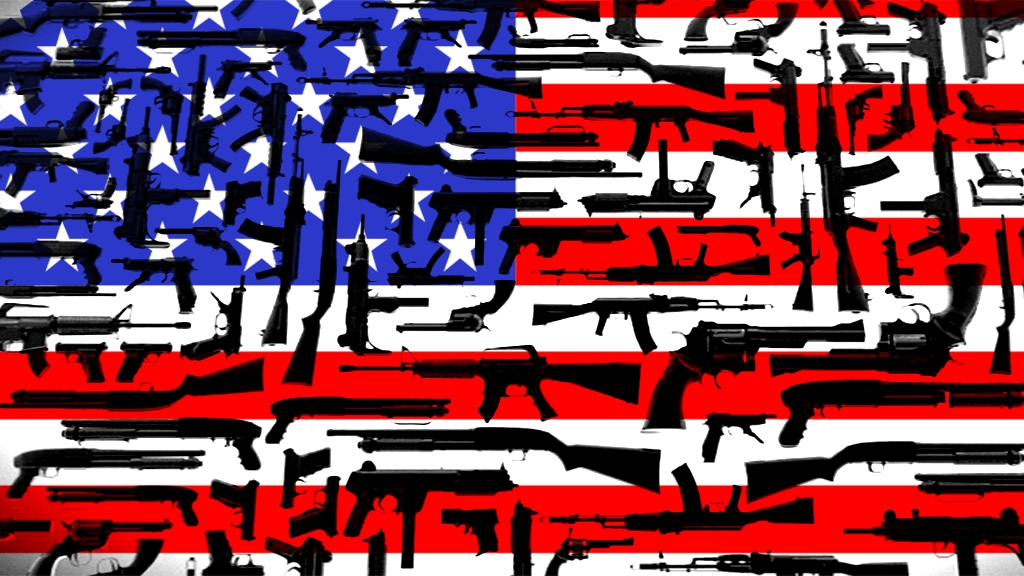By Alexander Casendino
Despite a troubling and violent past, the shooter responsible for killing 26 worshipers in the First Baptist Church in Sutherland Springs on November 5th managed to elude authorities and carry out the deadliest mass shooting in Texas history. This horrific event captured the nation’s attention. In such a tragic moment, an outside observer might think that America would come together as a unified country. Yet such a prediction does not fit the historical pattern.
Following the recent mass shootings in Las Vegas and Texas, the political divide over gun control in America remains unchanged. Those on the left call for greater firearm restrictions, while those on the right highlight the flaws of gun control and defend the Second Amendment. The pattern of political stalemate related to the issue of guns has yielded unfortunate consequences for the American public: according to a 2007 report by the Switzerland-based Small Arms Survey, the U.S. ranks number one in homicide-by-firearm rate among the world’s most developed nations.
 Those on the left and right agree that they would like to reduce the homicide-by-firearm rate in America, but rather than experimenting with different solutions to gun violence, political elites on the fringes of both parties pursue unhelpful strategies that transform the debate over gun control into a toxic political mess. Two specific strategies have worsened the partisan divide over guns: the relentless focus on mass shootings and the mobilization of fear by both parties’ elites. These frustrating debate tactics hinder debate over possible strategies to improve the safety and rights of gun owners and gun control advocates alike.
Those on the left and right agree that they would like to reduce the homicide-by-firearm rate in America, but rather than experimenting with different solutions to gun violence, political elites on the fringes of both parties pursue unhelpful strategies that transform the debate over gun control into a toxic political mess. Two specific strategies have worsened the partisan divide over guns: the relentless focus on mass shootings and the mobilization of fear by both parties’ elites. These frustrating debate tactics hinder debate over possible strategies to improve the safety and rights of gun owners and gun control advocates alike.
Focusing on Mass Shootings
Each mass shooting in this country is followed by intense media attention due to its violent nature and high level of casualties. Politicians, typically on the left, argue for reinstating a ban on assault weapons, a term used in the early 1990s to describe certain kinds of semiautomatic firearms, whereas those on the right refuse to pass further restrictions on firearms.
While mass shootings often serve as a spark that ignites debate over gun control in America, the disappointing reality is that gun violence is a daily occurrence in America. According to the CDC, there are roughly 33,000 gun-related deaths in the U.S. annually, with about ⅔ of them suicides and ⅓ of them homicides. Mass shootings account for just a small fraction of gun-related homicides in the United States — no more than a few percent per year depending on the definition of what constitutes a mass shooting.
Additionally, the focus on certain rifles, including shotguns and AR-15s, involved in some mass shootings draws attention away from the fact that rifles are not the typical weapon involved in gun-homicides. In 2012, F.B.I. data shows that only 322 people were murdered with any kind of rifle, whereas 6,371 people were murdered with handguns. The unfortunate reality of mass shootings is that these events often warp the debate over guns on both the left and right. These shootings receive the greatest amount of media time and politicians’ attention, whereas gun violence in America is a recurring issue on a day-to-day basis. Politicians on both sides of the political spectrum hamper productive debate on measures to reduce overall gun violence when they focus solely on gun issues in the aftermath of a mass shooting, which tends to invoke emotions rather than a rational debate.
Mobilizing Fear
Tragic mass shootings are usually followed by cycles of political paralysis that rely on hostile rhetoric from voices on the fringes of the political spectrum. Far-left politicians angrily hold the National Rifle Association (NRA) responsible, pointing fingers and immediately calling for solutions, which in turn angers Republicans and gives the NRA greater reason to respond with its own radical messages. For example, Senator Elizabeth Warren, one of the more radical anti-establishment figures in the Democratic Party, tweeted the following in the aftermath of the Las Vegas shooting in October:

Invoking the individuals that are killed during these mass shootings only serves to radicalize both sides, exemplified by the fact that those on the right viewed Senator Warren’s tweet as callous and offensive. Senator Warren and others on the left have invoked fear in their message, but those on the right are also guilty of this tactic.
Since the 1970s, during which the first federal regulations on firearms were passed, the NRA aligned itself closely with the Republican party to resist all forms of gun control. Just as the anti-establishment fringe on the left has mobilized fears against firearms, the NRA has mobilized fear against gun control. The NRA launched its own streaming service called NRATV a few weeks before the 2016 election in an effort to expand its message, but it is evident that many of these messages have been just as extreme compared to the far left in the gun debate.
In a short televised advertisement in June 2017, NRA spokeswoman Dana Loesch remarked upon the far left and mainstream media, concluding that “The only way we stop this, the only way we save our country and our freedom, is to fight this violence of lies with the clenched fist of truth.” Loesch’s comments were provocative, but much like Warren’s twitter remarks, these comments have done little to bridge the divide between Americans over the issue of guns. Fear is a powerful tool in politics, but the irrational and incendiary remarks made by figures on the far ends of the political spectrum have paralyzed meaningful debate on the issue of reducing gun deaths in this country.
A Way Forward
Preventing gun sales to those who have been convicted of violent misdemeanors, reducing gang participation and violence in cities like Chicago, and investing in programs that target mental health issues to reduce the roughly 21,000 gun-related suicides in the United States each year are just a small number of different proposals that could reduce gun-related violence in America. As acknowledged by the American Psychological Association, gun violence is often an extension of economic and social issues that vary across different individuals and districts. Experimenting and tailoring solutions to specific communities could also serve to reduce gun violence at the local level rather than the national level.
By no means would each of the solutions mentioned above prevent every mass shooting, homicide, or suicide, but each of these proposals could serve to reduce the number of gun-related deaths in the United States. However, liberals and conservatives figures on the fringes of the political spectrum continuously divide Americans after mass shootings and inspire fear, neither of which reduces gun violence in the U.S. Recognizing and identifying these harmful strategies is necessary to overcome the toxic political stalemate of gun control. Working towards new solutions to reduce gun violence can be far more effective and efficient if these political strategies are discarded.
Featured Image Source: www.theodysseyonline.com/america-guns






Be First to Comment